The Civilian Conservation Corps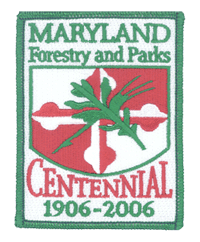
Part II: A Maryland Perspective
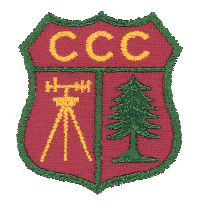 With
the creation of the Civilian Conservation Corps in 1933, Maryland was
fortunate to have 55,000 acres of state forest and park land and qualified
to operate over 15
camps of 200 men each, enabling the State's Forest Service to greatly improve
public forest lands,
develop some of its recreational potential, and implement important conservation
measures., which included extensive tree planting and improvements to
infrastructure that directly enhanced the ability to spot and fight forest
fires. The CCC put a total of 30,000 young unemployed men to work all over the state, but principally in Western Maryland.
With
the creation of the Civilian Conservation Corps in 1933, Maryland was
fortunate to have 55,000 acres of state forest and park land and qualified
to operate over 15
camps of 200 men each, enabling the State's Forest Service to greatly improve
public forest lands,
develop some of its recreational potential, and implement important conservation
measures., which included extensive tree planting and improvements to
infrastructure that directly enhanced the ability to spot and fight forest
fires. The CCC put a total of 30,000 young unemployed men to work all over the state, but principally in Western Maryland.
CCC
crews reclaimed forests and other natural resources, fought forest fires, built recreational
facilities and restored historic structures. They built lakes, cabins,
pavilions, trails, campgrounds and other visitor amenities, which Fred W.
Besley, Maryland's first State Forester (1906-1942) later indicated set Maryland’s forests and parks ahead by 25 years.
Over the nine years (1933 - 1942) the Civilian Conservation Corps (CCC) operated in Maryland , there was an average of twenty-one CCC Camps
in the state and any given time, with 15 of these camps sponsored by the State Board of Forestry
and located in State Forests and
State Parks.
|
State Forest & Park
CCC Camps in Maryland
Sponsored by the State Board of Forestry |
Project
Number |
Company
Number |
CCC Camps |
Post Office |
Federal
Sponsor |
| SP 1 |
1353 |
Fort Frederick State Park |
Big Pool |
NPS |
| SP 2 |
336 & 356 |
Patapsco State Park |
Elkridge |
NPS |
| S 5 |
1363 |
Elk Neck State Forest |
North East |
USFS |
| S 51 |
304 |
Potomac State Forest |
Mtn. Lake Park |
USFS |
| S 52 |
326 |
New Germany/Savage River State Forest |
Grantsville |
USFS |
| S 53 |
324 |
Green Ridge State Forest |
Flintstone |
USFS |
| S 54 |
335 |
Cedarville State Forest |
Brandywine |
USFS |
| S 57 |
2302 |
Gambrill State Park/ Frederick Municipal Forest |
Frederick |
USFS |
| S 58 |
1359 |
Little Orleans/Green Ridge State Forest |
Paw Paw |
USFS |
| S 59 |
304 |
Swallow Falls State Forest |
Oakland |
USFS |
| S 60 |
1320 |
Bond/Savage River State Forest |
Lonaconing |
USFS |
| S 62 |
1318 |
Pocomoke State Forest |
Snow Hill |
USFS |
| S 68 |
5461 |
Meadow Mountain/Savage River State Forest |
Swanton |
USFS |
| S 65 |
2366 |
Backbone Mountain/Potomac State Forest |
Swanton |
USFS |
| S 67* |
377 |
Piney Mountain/Swallow Falls State Forest |
Oakland |
USFS |
Notes:
- Under Federal Number, "SP" indicates a State Park project. "S"
indicates a State Forest Project.
- *S 67 at Piney Mountain was developed, but never staffed.
- NPS stands for National Park Service
- USFS stands for United States Forest Service
| Project Number: |
The number given by the state to the project and camp |
Company
Number: |
The number given by the federal government to each company. |
| Date: |
The date that company occupied that particular camp. |
| Post Office: |
The closest town to the camp that had a post office. |
|
Life in a CCC Camp
Life in a CCC camp resembled the regimented life on a military
base of the time. The physical camp was also laid out in military fashion and
consisted of four 50 man barracks, a kitchen, mess hall, recreation hall, army
reserve officers and statesmen quarters, as well as supply buildings, garages
and storage areas. The buildings were of pine lumber covered with tar paper and
wood strips. The buildings were constructed in four foot sections for easy
relocation when the camp moved.
The standard wage was $30 a month with $25 of this wage going directly to the
worker's families or parents. The work was hard and demanding and much of the
legacy of that work is with us today.
Despite the rigors of their CCC days, most veterans of the "Tree Army" looked
back on those days as a positive, character building time of their lives. One
Western Maryland veteran said "...I firmly believe the CCC's were the second
best experience of my life. My wife was the first."
Garrett County CCC Camps
Camp S 52: New Germany State Forest Recreation Area
in Savage River State Forest
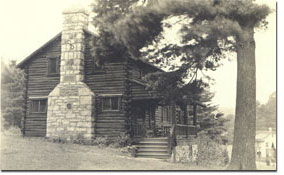 Before the 1929 acquisition of the Savage River State Forest by the Federal
Utilization Land Program and the State Board of Forestry, New Germany was a
milling center where a crudely-built lake had been developed by damming "Poplar
Lick Run." The lake was called Swauger's Dam", a tribute to John and Charles
Swauger who built the dam.
Before the 1929 acquisition of the Savage River State Forest by the Federal
Utilization Land Program and the State Board of Forestry, New Germany was a
milling center where a crudely-built lake had been developed by damming "Poplar
Lick Run." The lake was called Swauger's Dam", a tribute to John and Charles
Swauger who built the dam.
Both a saw mill and a grist mill were developed at New Germany that used water
power from the lake. Also, in winter, ice was cut from the lake, packed in
saw dust, and stored in an ice house to be sold in the summer. The mills
and ice business were operated by the McAndrews family (two brothers and a
sister), who also added to the site one of the original "Jot em Down" stores,
where dry goods and fuel were sold.
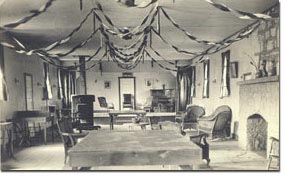 The alpine valley where the milling village of New Germany was nestled was and
still is delightfully picturesque. It is both historic and beautifully
natural, partly because of a unique stand of hemlock and white pine that is
found near the lake. Therefore it was an ideal location for one of the
first CCC tent camps in June 1933.
The alpine valley where the milling village of New Germany was nestled was and
still is delightfully picturesque. It is both historic and beautifully
natural, partly because of a unique stand of hemlock and white pine that is
found near the lake. Therefore it was an ideal location for one of the
first CCC tent camps in June 1933.
CCC Camp S-52 crews built many of the
park's recreation facilities, including cabins, campsites and trails. The CCC's
maintenance of forest roads better protected the forest from wildfires and laid
the foundation for future forest management practices to improve these public
lands.
CCC Projects at at New Germany:
- CCC Structures - - Many still in use today, included platforms for their tent camp,
mess hall, six barracks, Recreation Hall (still in use) Officer's Quarters
(still in use as a vacation cabin), Headquarters Building.
- Swauger's Dam - - Removed existing dam and built a larger dam which increased the lake size
to 13 acres.
- Day-use recreation area - - around and near the lake to include:
bathhouse, boat-house, gazebo, two large pavilions, several single table
picnic shelters, fire places and latrines.
- Overnight facilities - - to include a tent camping area and ten
housekeeping log cabins.
- Ski trails and ski slopes - -
became first ski resort area in Maryland
- Support facilities - - for the recreation area included roads, parking lots,
water carrying sewage disposal system, and well and water storage reservoir.
- Thousands of trees - - were planted in the state forest, and considerable
timber-stand improvement was accomplished. Many forest fires were
brought under control.

The New Germany camp closed in 1938. Personnel and equipment were moved to
the Meadow Mountain CCC Camp, S 68. Crews of CCC boys were still trucked
to New Germany to complete recreation and forestry projects until the CCC camps
closed in 1942.
Camp S 59: Swallow Falls & Herington Manor State Forest
Recreation Areas
in Swallow Falls State Forest (now known as Garrett State Forest)
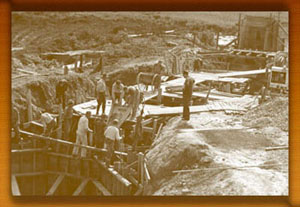 Improvements by the CCC to Swallow Falls State Forest and its two forest
recreation areas, now known as Swallow Falls and Herrington manor State Parks,
were accomplished by the 304th Company CCC located at Camp 59 at what is now the
site of the Swallow Falls camping area entrance.
Improvements by the CCC to Swallow Falls State Forest and its two forest
recreation areas, now known as Swallow Falls and Herrington manor State Parks,
were accomplished by the 304th Company CCC located at Camp 59 at what is now the
site of the Swallow Falls camping area entrance.
Swallow Falls State Forest was a 1,917 acre gift from brothers John and Robert
Garrett in 1906 and was offered to the State of Maryland, providing the state
would start a forestry service. The area that is now Swallow Falls State
Park, where the CCC camp was located, was part of a 600-acre tract known as
"Falls of Muddy Creek," and it was adjacent to the Garrett gift.
The Falls of Muddy Creek tract contained a magnificent, 40-acre stand of old
growth hemlock and white pine that one if the site's earliest owners, Henry
Krug, could not bring himself to cut. The old growth trees were so old and
so magnificent that lumberman and whiskey barrel maker Krug protected them.
At his death he willed the property to the Grand Lodge of Masons of Pennsylvania
and West Virginia as a retreat center.
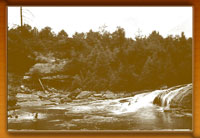 The majestic old growth forest, where some trees are now estimated to be more
than 360 years old, is bordered by the cascading Youghiogheny River and Muddy
Creek, where Maryland's highest waterfall drops 65 feet. The site is considered
to be Maryland's best example of a primeval northern hemlock forest and one of
the most beautiful and picturesque spots in the state.
The majestic old growth forest, where some trees are now estimated to be more
than 360 years old, is bordered by the cascading Youghiogheny River and Muddy
Creek, where Maryland's highest waterfall drops 65 feet. The site is considered
to be Maryland's best example of a primeval northern hemlock forest and one of
the most beautiful and picturesque spots in the state.
In 1923, the State Board of Forestry and the Grand Lodge of Masons entered into
an arrangement whereby the state would manage and protect the Falls of Muddy
Creek property as an Auxiliary State Forest as had been done at other scenic
forested area in the state. As a result of this joint land-use agreement,
Maryland was able to locate a CCC camp on the property for the purpose of making
improvements to both Forest Recreation Areas and the Swallow Falls State
Forest.
The other recreation area was located at Herrington Manor, just four miles to
the south on a 656-acre tract donated in 1917 to the state by Henry and Julian
Leroy White. Swallow Falls State Forest lay in-between and adjoined the two
recreation areas.
The CCC projects at Swallow Falls and Herrington Manor State Forest Recreation
areas were similar to the New Germany projects except these larger in number and
scale.
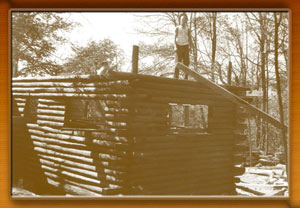 Company
304, Camp S-59 of "Roosevelt's Tree Army," assigned to Swallow Falls State
Forest, was organized in Baltimore on April 7, 1933 with 100 men on the roles.
The company was the fourth company to be organized in the United States. Company
304 was sent to Virginia, Deer Park and Camp Ritchie, Maryland before moving to
Swallow Falls on May 14, 1934. By October of 1934, barracks to house the men
were erected and the company moved in and stayed at Swallow Falls until May 20,
1940.
Company
304, Camp S-59 of "Roosevelt's Tree Army," assigned to Swallow Falls State
Forest, was organized in Baltimore on April 7, 1933 with 100 men on the roles.
The company was the fourth company to be organized in the United States. Company
304 was sent to Virginia, Deer Park and Camp Ritchie, Maryland before moving to
Swallow Falls on May 14, 1934. By October of 1934, barracks to house the men
were erected and the company moved in and stayed at Swallow Falls until May 20,
1940.
Herrington Manor State Park was the site of many Federal Civilian Conservation Corps (CCC) work projects.
Young men from throughout the State lived at a camp located nearby at present
day Swallow Falls State Park. These CCC crews created Herrington Lake,
planted trees and constructed ten log cabins and the beach Lake House.
The park's dominant feature is a manmade 53-acre lake, averaging a depth of eight feet. Fed by Herrington Creek,
the lake was dammed in the early 1930s by the Civilian Conservation Corps, and
is now open from dawn till dusk, seven days a week, for swimming, fishing and
boating.
CCC Projects at Herrington Manor State Park
- Earthen Dam and Lake
-- Construction of the Herrington Manor Dam and Lake began on May 18, 1934.
The dam was built of coursed stones brought to the site from the Swallow Falls
area.
- Cabins -- Cabins one through ten are in a 20th century historic
district reflecting the mid 1930's CCC building style. The cabins are formed
of rounded chestnut logs cut flat on their top and bottom surfaces and
overlapping at the corners. The logs are placed against each other without any
sort of chinking or daubing. There is no notching involved in the corner joints,
which are secured with nails. The foundations consist of stone piers at the
corners and at intervals along the walls. Including these historic cabins, a
total of 20 logs cabins are available for year round vacation rental by
reservation.
- Lake Concession
-- Formerly a stone bathhouse on the shore of Herrington Lake, the bathhouse
was a three-bay structure built of coursed local stones. This building was
renovated and added to in 1986. The original archways are now inside the
present building.
- Restroom at the beach -- This was once the
CCC pump house. Now this building is a restroom
facility.
- Barracks--
Two barracks from Swallow Falls were disassembled in four foot sections and
moved to Herrington Manor. These buildings are in use today as storage
buildings and a lounge/display in the shop complex.
CCC Projects at Swallow Falls State Park
- Pavilion--
The stone and frame pavilion is located across from the parking lot.
- Camp office-- The camp office sits on its original site within Company 304's camp. This
building was more likely one of the officer's headquarters. This structure's
interior has been renovated but its exterior is the original chestnut.
- Restroom--
A stone restroom is located on top of the hill above the parking lot. This
building is closed to the public.
- Dynamite Shed-- A small building located in the youth group campground, this shed was once
used to store the camp's dynamite supply.
Camp S 60: Big Run State Forest Recreation Area
in Savage River State Forest (known as the Bond CCC Camp)
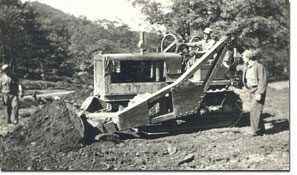 The Bond CCC Camp in the Savage River State Forest was located north of the Big
Run State Forest Recreation Area and the Savage Reservoir.
The Bond CCC Camp in the Savage River State Forest was located north of the Big
Run State Forest Recreation Area and the Savage Reservoir.
The CCC boys at the Bond Camp worked on the Big Run Recreation Area, which had a
small day use area with a large log shelter and a cabin area with 13
rustic cabins with no running eater. This area was designed for fishermen
and youth groups, The cabins were later taken down since the area could
not be closed at night, due to a county road that passed through it. The
Bond CCC boys also worked extensively on state forest improvements and forest
fire suppression.
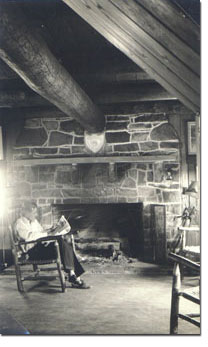 They may have also constructed the Whiskey Hollow ski slope, which is a
challenging serpentine path that propels skiers down from the top of Meadow
Mountain. The CCC attempted to advance skiing by creating opportunities in
Garret County, such as that at New Germany described above, although the
effort was ahead of its time. Limited roads from big cities, unpredictable
weather patterns, and a depressed economy had to be overcome before skiing would
become a money-making venture in Western Maryland.
They may have also constructed the Whiskey Hollow ski slope, which is a
challenging serpentine path that propels skiers down from the top of Meadow
Mountain. The CCC attempted to advance skiing by creating opportunities in
Garret County, such as that at New Germany described above, although the
effort was ahead of its time. Limited roads from big cities, unpredictable
weather patterns, and a depressed economy had to be overcome before skiing would
become a money-making venture in Western Maryland.
S 51 Potomac State Forest
(known then as Camp Active)
The Potomac State Forest was started in 1932 with the purchase of lad by the
Federal Land Utilization Program that was established to help struggling
landowners whose farms and businesses were were not successful and in need of a
fresh start. The lands were turned over to a state or federal conservation
agency which would reforest them. Many of these purchases were along
waterways, with the plan to control soil erosion and improve water quality.
The Potomac River is quite alpine in appearance at the Potomac State Forest with
white foamy cascades bordered by a mix of pine, hemlock, oak and maple forest.
It is strikingly beautiful in any season of the year.
The 304th Company CCC was established May 22, 1933. The state forest was
under the capable supervision of M. Carlton Lohr, the resident Forest Warden.
Carl, a native from a Garrett County farm family, was a planner and capable
administrator who worked well with his US Army counterparts, and together they
created a model State Forest Demonstration Area with a small primitive camping
area and a day use area for picnicking. However, reforestation if the Potomac
River watershed was the main objective.
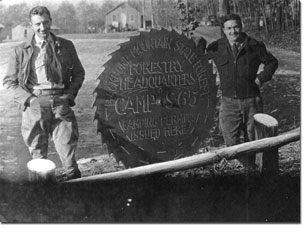 The one unique facility that the CCC boys constructed was a large log house to
serve as the forest headquarters and the forest superintendent's home. The
house had a large wide front porch and was the site of many meetings of visiting
groups who studied forestry practices. Mrs. Ruth Lohr was the gracious
hostess, who enjoyed providing refreshments to the many groups of frequent
visitors.
The one unique facility that the CCC boys constructed was a large log house to
serve as the forest headquarters and the forest superintendent's home. The
house had a large wide front porch and was the site of many meetings of visiting
groups who studied forestry practices. Mrs. Ruth Lohr was the gracious
hostess, who enjoyed providing refreshments to the many groups of frequent
visitors.
First Lieutenant D.W. Santelle, 3rd Calvary, was company commander. Mr.
Lohr and Lt. Santelle both agreed when they said, "The men have worked well.
Brown backs and big appetites testify to that. The morale is excellent; the
willingness of the men is very gratifying. All of them seem to feel that
the phrase 'the dignity of labor' has real meaning. And the results have been
splendid."
As FDR said, "..every boy should have the opportunity to work for six months in
the woods. This was the happiest of the New Deal Programs, for it simultaneously
rehabilitated the land and the men."
The
CCC Fish Rearing Ponds Trail in Potomac State Forest offers a short, easy hike through mixed hardwood forest. At the end,
keen-eyed observers will notice the subtle remains of several former, now dry,
fish rearing ponds built by Civilian Conservation Corps members in the 1930s.
Other Major CCC Camps in Maryland
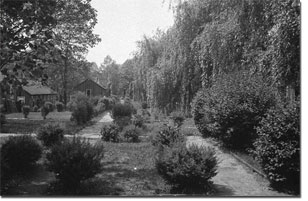 Patapsco State Park (now known as Patapsco Valley State Park)
Conservation efforts began in the river valley in 1907 when the Patapsco State
Forest Reserve was established. During the Depression years of the 1930s,
President Franklin D. Roosevelt's Civilian Conservation Corps (CCC) planted
trees and built trails, picnic areas, campsites and handsome cut-stone pavilions
to improve what had by then become "Patapsco State Park".
Patapsco State Park (now known as Patapsco Valley State Park)
Conservation efforts began in the river valley in 1907 when the Patapsco State
Forest Reserve was established. During the Depression years of the 1930s,
President Franklin D. Roosevelt's Civilian Conservation Corps (CCC) planted
trees and built trails, picnic areas, campsites and handsome cut-stone pavilions
to improve what had by then become "Patapsco State Park".
Company 356 of the Civilian Conservation
Corps made its encampment near Lost Lake at Camp Tydings in the Avalon Area. The
CCC built the
stone picnic shelters in Orange Grove and Glen Artney (not visible from the
river). The CCC was also responsible for planting trees in the
river valley to advance the reforestation efforts and reclaim the over-used and
abused land.
This
Civilian Conservation Corps Camp (CCC) was operational between 1933 and 1942. Following the start of World War II, the CCC
Camp was converted to the nation's first Conscientious Objector Camp.
Fort Frederick State Park
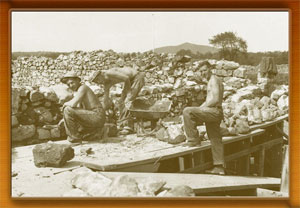 After the Civil War, various local patriotic organizations kept the 1756 stone fort's history alive, and in 1922 the State repurchased the crumbling walls and adjacent land to begin development of Maryland's first state park.
After the Civil War, various local patriotic organizations kept the 1756 stone fort's history alive, and in 1922 the State repurchased the crumbling walls and adjacent land to begin development of Maryland's first state park.
During the Great Depression, Company 1353 of the Civilian Conservation Corps was assigned to the park to reconstruct the stone walls, and perform archaeology work in order to locate the foundations of the original interior buildings. They also were tasked with developing the park land.
In 1934, Camp SP-1 started out as tent city just south of the fort, but soon grew into a u-shaped camp west of the fort. The camp included three barracks, shower houses, recreation hall, kitchen and mess hall, officers’ quarters, hospital, forester’s office and classroom as well as several sheds. At that time the CCC also constructed a park visitor center (now the CCC Museum), Superintendent’s House (now the Park Store), horse stables (now the park’s Nature Center), blacksmith shop and garage all in a colonial style. In addition to the work around the fort the CCC constructed a picnic area with public restrooms and a picnic pavilion that can still be used by visitors to this day. Members of Company 1353 also worked at Washington Monument State Park.
Washington Monument State Park
In 1920, the one acre site was purchased by the Washington County Historical
Society, and in 1934 it was deeded to the State of Maryland for use as a State
Park. The tower was rebuilt in its present form by members of the Civilian
Conservation Corps, who set in place the original cornerstone and a facsimile of
the dedication tablet. Development of a 40-acre park was started. The size of
the park has since increased to 108 acres.
The third dedication ceremony was held on July 4, 1936, exactly 109 years
after that first day of patriotic activity by the citizens of Boonsboro, which
produced the beginnings of the country's first monument to George Washington.
Cunningham Falls State Park
In 1936, the federal government created the Catoctin Recreational
Demonstration Area by acquiring more than 10,000 acres to demonstrate the
restoration of forest lands. The Civilian Conservation Corps (CCC) and the Works
Progress Administration (WPA) built many facilities in the Demonstration Area,
including cabins and shelters.
Gambrill State Park
Most of the recreational facilities still in use at the
park were constructed by the Civilian Conservation Corps (CCC) during the Great
Depression of the 1930s, including three stone overlooks to take advantage of
the views. The park's Tea Room,
a stone lodge available for public use, is a particularly fine example of the
type of recreational structures built by the CCC.
Cedarville State Forest
In the 1930s, the State began purchasing land in an effort to create a
forest demonstration area. It was the CCC boys who developed
Cedarville's roads and trails for fire protection and future recreation
development. From 1933 to 1935, approximately 160 men of the CCC, mostly
African Americans from Baltimore and Washington, D.C., worked at Cedarville.
Five barracks, originally located across from the current forestry buildings,
housed up to 50 men each.
Acknowledgements:
The editor of this article gratefully acknowledges the
following persons whose contributions made it possible to present this
perspective of the CCC in Maryland. Where errors may occur, Maryland DNR
will sincerely appreciate any corrections, clarification or additional
comments from former CCC members and their families, or from historians
who may have a more accurate factual record.
-
Garrett County CCC Camps, courtesy of...
Offutt Johnson... spent most of his 35-year career with the Department
of Forest and Parks and the Dept. of Natural resources in Annapolis, Md.
For 26 of those years he worked for Program Open Space. His last ten
years with DNR, Mr. Johnson was involved in nature and history projects,
most notably at Patapsco Valley State Park where he directed the
renovation of an old stone iron workers' house into the Park's first
history center for visitors. He and his wife Joan moved to Oakland after
his retirement. He continues to volunteer by working on a history of
Maryland's state forests and parks.
-
Life in a CCC Camp and additional
information regarding CCC work at
Swallow Falls and Herrington Manor, courtesy of ...
Caroline Blizzard... served as a Park Naturalist at Herrington Manor
State Park and is currently Director of the Discovery Center at Deep Creek
Lake State Park. She has been with DNR for 16 years.
Photographs (top to bottom):
- Emblem
worn by Civilian Conservation Corps (CCC) crews in Maryland (1933),
courtesy of Greg Bartles
- New Germany State Park - Cabin 11, originally CCC
Officer's Quarters 1939
- Interior - CCC New Germany Rec Hall 1936
- New German CCC Camp S-52, Headquarters & Barracks, 1936
- CCC boys constructing earthern dam to form lake at
Herrington Manor, 1934
- Bathers in pool below Muddy Creek Falls
- Civilian Convervation Corp worker on roof of cabin at
Herrington Manor State Park - 1930's
- Bond CCC Camp S-60, 1934 photo courtesy of Robert Gerfin
- Interior Bond Camp Headquarters - CCC Camp S-60, Photo by
Fred W. Besley
- Potomac State Forest Entrance to Backbone Mountain CCC
Camp S-65
- CCC Camp SP-2 - Patapsco State Park
- CCC Boys reconstructing stone wall at Fort Frederick, CCC
Camp SP-1